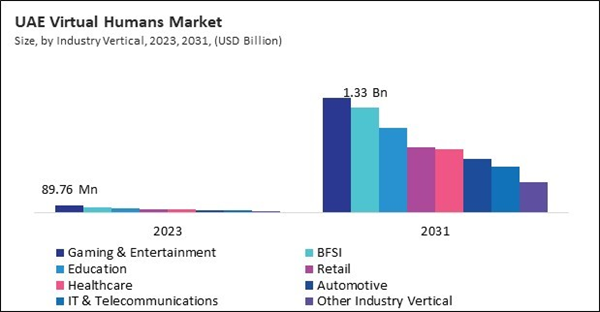The Brazil market dominated the LAMEA Virtual Humans Market by country in 2023, and is expected to continue to be a dominant market till 2031; thereby, achieving a market value of $16.02 billion by 2031. The Argentina market is expected to witness a CAGR of 48.6% during 2024-2031. Additionally, the UAE market would register a CAGR of 45.3% during 2024-2031.
Consumers embrace virtual humans in various forms, such as digital influencers, AI-powered avatars, and virtual assistants. This is particularly evident in the entertainment, gaming, and e-commerce industries, where consumers enjoy personalized experiences and interactive engagements with virtual humans. With the proliferation of mobile apps, social media platforms, and virtual reality, consumers are finding it easier to interact with virtual humans across different touchpoints in their daily lives.
Governments and healthcare institutions are adopting virtual humans to provide information, deliver services, and enhance public interactions. In healthcare, virtual health assistants are expanding, enabling patients to access healthcare information, book appointments, and receive preliminary medical advice. Governments are also experimenting with virtual humans to assist citizens in navigating public services, answering queries, and delivering administrative services.
The UAE is at the forefront of integrating advanced technologies through its Smart Cities & Artificial Intelligence Plan (2018-2022) and the National Smart Mobility Strategy, which is part of the broader National Artificial Intelligence Strategy 2031. These initiatives aim to leverage Information and Internet of Things (IoT) Technology for managing infrastructure and establish the UAE as a global leader in artificial intelligence by 2031.
These strategic initiatives are significantly boosting the adoption of virtual humans in the UAE. Smart city projects require sophisticated AI-driven systems to manage infrastructure and services efficiently, including deploying virtual assistants for public services, urban management, and customer engagement in various sectors. The focus on AI and smart technologies positions the UAE as a lucrative market for virtual humans, facilitating advancements in AI-driven virtual assistants, interactive customer service avatars, and human-like robots for urban management and public interaction. Thus, the economic growth in Brazil, characterized by rising retail trade, and the UAE’s strategic initiatives in smart cities and artificial intelligence, are crucial drivers for the virtual humans market.
List of Key Companies Profiled
- Epic Games, Inc.
- Alibaba Cloud (Alibaba Group Holding Limited)
- Unity Software Inc.
- Meta Platforms, Inc.
- Google LLC (Alphabet Inc.)
- IBM Corporation
- Microsoft Corporation
- Amazon Web Services, Inc. (Amazon.com, Inc.)
- Apple Inc.
- NVIDIA Corporation
Market Report Segmentation
By Type
- Avatars
- Autonomous Virtual Humans
By Industry Vertical
- Gaming & Entertainment
- BFSI
- Education
- Retail
- Healthcare
- Automotive
- IT & Telecommunications
- Other Industry Vertical
By Country
- Brazil
- Argentina
- UAE
- Saudi Arabia
- South Africa
- Nigeria
- Rest of LAMEA
Table of Contents
Companies Mentioned
- Epic Games, Inc.
- Alibaba Cloud (Alibaba Group Holding Limited)
- Unity Software Inc.
- Meta Platforms, Inc.
- Google LLC (Alphabet Inc.)
- IBM Corporation
- Microsoft Corporation
- Amazon Web Services, Inc. (Amazon.com, Inc.)
- Apple Inc.
- NVIDIA Corporation
Methodology

LOADING...








